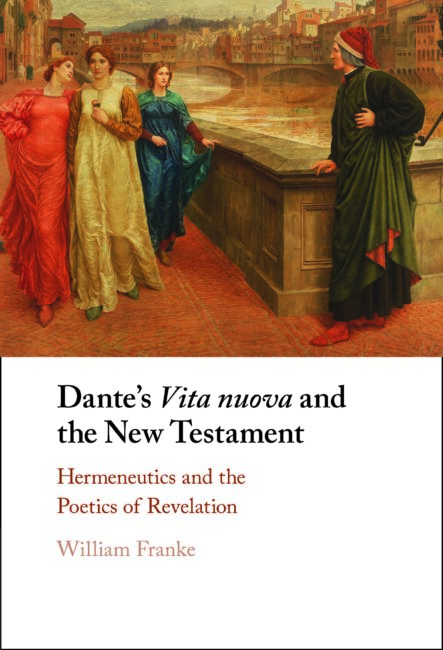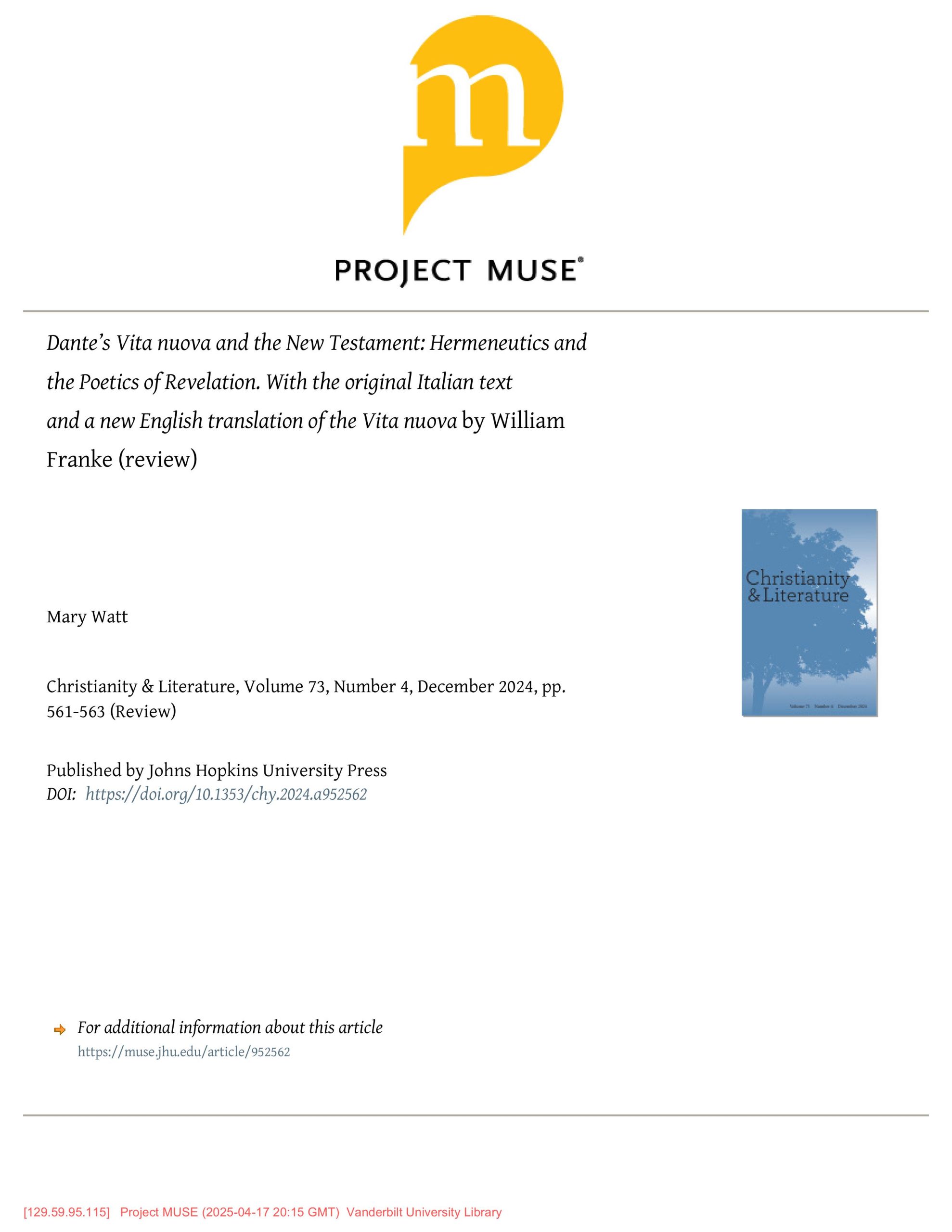VN
Dante’s Vita Nuova and the New Testament: Hermeneutics and the Poetics of Revelation


“As if called forth on cue by our time and its crises, Dante demonstrates how theology can be crucial to the continuing intelligibility and viability of the humanities. Dante’s translation of theological doctrine into poetic vision is key to our being able to continue to receive the saving graces of religion and humanities alike in our current twice-over secularized culture and technologized world. Dante is among our greatest guides to how we can still benefit from our human wisdom traditions and their spiritual vision. We can and need to be galvanized by these resources in their broader potential for shedding a light of truth open to infinity in this unprecedentedly perilous situation for human culture susceptible to collapsing and succumbing to a “post-truth” condition.” –from Prologue
AWARD WINNER: Hermes Award: Book of the Year in Phenomenological Hermeneutics, Agora Hermeneutica, The International Institute for Hermeneutics (IIH), 2021
Publishers Website (Cambridge University Press)
‘This book, which includes the original text and a new, spirited English translation of it, proves beyond any reasonable doubt that the presence of the Christian New Testament on young Dante’s mind when he wrote the Vita nuova is not just occasional – it is indeed part of Dante’s determined effort to write a kind of ‘sacred story’ long before he conceived the ‘sacred poem’ – the Divine Comedy. William Butler Yeats once wrote, in a poem entitled after Dante’s Vita nuova ‘Ego Dominus Tuus’, that Dante ‘has made that hollow face of his / more plain to the mind’s eye than any face / but that of Christ’. Franke now shows that there is more to the Irish poet’s lines than we thought. He bravely confronts the problems of hermeneutics which making his ‘face’ plain in the Vita nuova’s love story might imply for its author and proposes, shedding light on both texts, that this strange ‘autobiography’ deliberately looks for a ‘poetics of revelation’ and is constructed as a true ‘New Testament’.’ Piero Boitani, Emeritus, Comparative Literature, Sapienza University of Rome
‘Professor Franke’s original, tightly argued study makes a significant contribution to the reappraisal of Dante’s youthful masterpiece by offering, at once, a fresh translation and a well-rounded interpretation. Dante’s Vita Nuova and the New Testament is to be welcomed for its concern to present Dante’s libello to an Anglophone readership, as it offers a global interpretation of the Vita nuova at the crossroad between Biblical and philosophical traditions.’ Giuseppe Ledda, Università di Bologna
Sowell Madison review of VN bk
Mary Watt review, Christianity & Literature Volume 73, Issue 4 (December 2024).
Franke, William. Dante’s Vita nuova and the New Testament: Hermeneutics and the Poetics of Revelation. With the original Italian text and a new English translation of the Vita nuova. Cambridge, UK: Cambridge University Press, 2021. 244 pp. ISBN 978-1-316-51617-1
It is a testament to the elegance and focused writing style of William Franke that this sweeping commentary on the Vita Nuova is actually rather short. (While the volume contains 244 pages, the last 80 or so pages are taken up with the original Italian text and Franke’s superb translation thereof.) This is not to say that the study is in any way lacking; indeed, in my opinion, Franke, a Professor of Comparative Literature and Religious Studies at Vanderbilt University, has produced here what should be considered the definitive study of Dante’s first book-length project.
From the opening lines of the Prologue to the closing arguments of the Conclusion, Franke explores how Dante constructs the Vita nuova, such that the libello (the little book) becomes an instrument of revelation, revealing its ultimate significance not only to the poet protagonist but also to Dante’s readers – including William Franke.
Franke wastes no words. Using prose that is both compact and fluid, he elucidates complex ideas in such a way that the reader cannot help but nod in agreement, marveling at why no one had seen this before Franke. The answer to the question is implicit in the Prologue, where Franke locates his examination in the context of the recent revolution in literary theory. While this revolution has generated a plethora of new approaches, it has ignored (or, perhaps, intentionally eschewed) the connection between literature and religion. As a result, Dante studies, in recent years, have missed the obvious; Dante, Franke asserts, “places his own literary production in a zone nearly continuous with revelation in the Bible.”
In the Introduction, Franke supports this assertion as he shows how the Vite nuova functions as theological revelation through lyrical interpretation. The lyric mode is, for Franke, the key to Dante’s understanding of Beatrice’s significance in his own salvation. The Vita nuova, he contends, owes its “incomparable visionary power to the musical and emotional qualities of lyric.” Franke’s reading, of course, necessarily depends upon and accepts the existence of the soul, and thus, his reading necessarily moves, like Dante’s, ever closer to a theological zone. But, yes, this makes perfect sense! This is what Dante intended all along.
The next chapter, “The New Testament Model for Salvific Reminiscence” considers the specific models upon which Dante relies to signal the salvific significance of Beatrice’s appearance in his life. Here, Franke argues that Dante uses a process similar to that of the a posteriori narrativization of poetic prophecy found in the Gospel of John to gradually reveal about Beatrice what he did not know at first but which is later revealed to him. Further, Franke observes that in the Vita nuova, as in the miracle stories about Jesus, even when the Gospel invokes the rhetoric of factuality, the “facts are always presented as signs.”
The conclusion drawn in the next chapter, “The Vita Nuova’s Hermeneutics of Witness,” naturally follows as Franke examines Dante’s experience of Beatrice as his ‘beatifier.’
This revelation, he suggests, is akin to the revelation of Jesus as the Christ, which is “inextricably bound up in the disciples’ personal experience in relation to Jesus and with their lyrical, poetic expression of it.” (33) Moreover, as in the case of the gospels, in Dante’s recollection of the experience of Beatrice, the memory becomes a way of actualizing revelation in the present.
In Chapter 4, “Phenomenology versus Hermeneutics: Revelation as Mediation,” Franke debates the position taken by Dante scholar Robert Harrison, author of The Body of Beatrice. Harrison’s assertion of the absolute priority of Dante’s experience of Beatrice as a woman rather than as a beatifier, according to Franke, boxes reality into the narrow experience of a subject. In this chapter lies the kernel of Franke’s engagement with the Vita Nuova and provides the foundation for the chapters that follow, where he presents a new hermeneutics-centered critical paradigm. It also leads to his conclusion that poetry is the generative source of Dante’s narrative, the source of, Dante’s own gospel, “the good news according to Dante,” in which he chronicles the revelation of Beatrice as a beatifier.
The Epilogue in which Franke examines the role of dreams in the revelatory process in
Dante’s literary project could, in many ways, may I suggest, equally function as the introduction. While he presents this focus on the dream in the Vita nuova as a denoue
ment and supplement to the preceding chapters, Franke’s reminder that Dante believed in the dream as a real revelation of the immortality of the soul (139,) suggests that a study of the dream might also be an apt starting point for an exploration of Dante’s experience of revelation in his waking state.
It is in this circular quality of Franke’s analysis that we see both its brilliance and its completeness. While other readings, such as Harrison’s, become linear and finite, Franke’s mirrors Dante’s ultimate revelation, articulated in Paradiso 30, where the river of time circles back on itself, fusing time and space and revealing a truth that is enduring and infinite. In the same spirit, then, I return to my opening comments and reiterate that this latest offering from William Franke should be the starting point of any serious study of Dante’s Vita nuova.
Mary Watt
University of Florida
**********
Abreu de Lima, Heloísa.
2025. Interpreting Beatrice: The
Critical Reception of the Character in
the Last Twenty-Five Years.
Humanities 14: 131. https://
doi.org/10.3390/h14060131
The idea that the Vita nuova is a text similar to the Gospels is developed to its full
extent by William Franke, whose edition and translation of the Vita nuova is introduced by an extensive study that addresses important interpretive issues concerning Beatrice (Franke 2021). According to Franke, Beatrice is undoubtedly a Christ-like person, and this can be proved not only by the oft-quoted analogy stated at chapter 24, but also by different claims made by Dante concerning her beatifying power-claims that, in Dante’s cultural and religious context, could not rely on any model other than Christ. In this regard, Beatrice “is strikingly like the one who proclaims himself ‘the way, the truth, and the life’ (John 14: 6)” (Franke 2021, p. 2): she is herself the “new life”, the deep religious meaning of the work’s title, beyond the common meaning referring to Dante’s “youth”. Although many claims made by Dante throughout the Vita nuova might seem like heterodox idolatry, Franke notes that Beatrice should not be understood as a surrogate for Christ: she is the bridge through which Christ reaches Dante, incarnating Christ for Dante and constituting his personal experience of the miraculous and divine. This interpretation of Beatrice is the foundation of Franke’s extensive reading of the Vita nuova, which proposes to use the Gospels “as the model of a book written in loving memory of a person whose significance is—and must remain—central in the life of the author(s)” (Franke 2021, p. 8).







©2025 Vanderbilt University ·
Site Development: University Web Communications